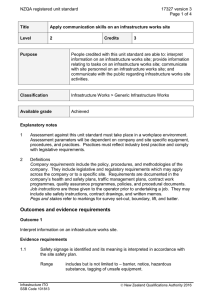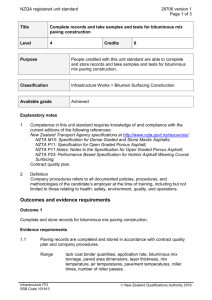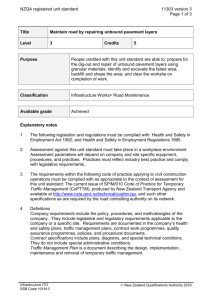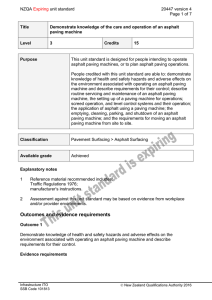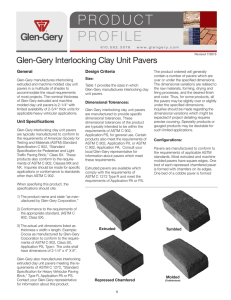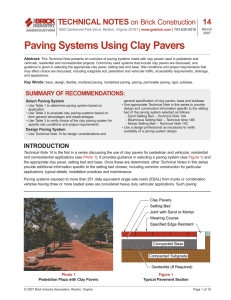NZQA registered unit standard 26719 version 1 Page 1 of 3
advertisement
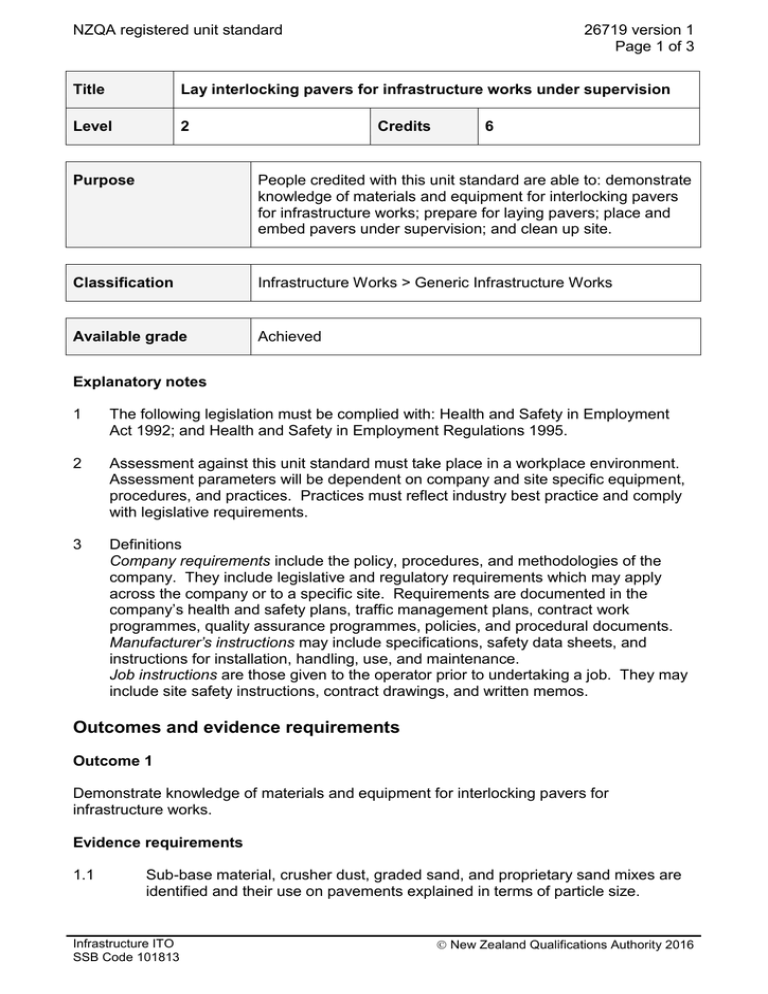
NZQA registered unit standard 26719 version 1 Page 1 of 3 Title Lay interlocking pavers for infrastructure works under supervision Level 2 Credits 6 Purpose People credited with this unit standard are able to: demonstrate knowledge of materials and equipment for interlocking pavers for infrastructure works; prepare for laying pavers; place and embed pavers under supervision; and clean up site. Classification Infrastructure Works > Generic Infrastructure Works Available grade Achieved Explanatory notes 1 The following legislation must be complied with: Health and Safety in Employment Act 1992; and Health and Safety in Employment Regulations 1995. 2 Assessment against this unit standard must take place in a workplace environment. Assessment parameters will be dependent on company and site specific equipment, procedures, and practices. Practices must reflect industry best practice and comply with legislative requirements. 3 Definitions Company requirements include the policy, procedures, and methodologies of the company. They include legislative and regulatory requirements which may apply across the company or to a specific site. Requirements are documented in the company’s health and safety plans, traffic management plans, contract work programmes, quality assurance programmes, policies, and procedural documents. Manufacturer’s instructions may include specifications, safety data sheets, and instructions for installation, handling, use, and maintenance. Job instructions are those given to the operator prior to undertaking a job. They may include site safety instructions, contract drawings, and written memos. Outcomes and evidence requirements Outcome 1 Demonstrate knowledge of materials and equipment for interlocking pavers for infrastructure works. Evidence requirements 1.1 Sub-base material, crusher dust, graded sand, and proprietary sand mixes are identified and their use on pavements explained in terms of particle size. Infrastructure ITO SSB Code 101813 New Zealand Qualifications Authority 2016 NZQA registered unit standard 1.2 Paving equipment is identified on site and its use described in accordance with company requirements. Range 1.3 26719 version 1 Page 2 of 3 straightedge, side runner, screed rail, screed, bolster chisel, paving splitter, rubber hammer, rammer, concrete cutter, cobble cutter. Types of paving block are identified and described and differences in strength and thickness are explained in relation to suitability for infrastructure works applications. Outcome 2 Prepare for laying pavers for infrastructure works. Evidence requirements 2.1 Job instructions are confirmed with supervisor in accordance with company requirements. Range 2.2 includes but is not limited to – site safety, bedding material, paver type and thickness, jointing material. Personal protective equipment is selected, fitted, and worn in accordance with company requirements and manufacturer’s instructions. Range may include – overalls, safety footwear, gloves, reflective vest, hearing protection, eye protection, hard hat. Outcome 3 Place and embed pavers for infrastructure works under supervision. Evidence requirements 3.1 The use of paving equipment is demonstrated in accordance with manufacturer’s instructions and company requirements. Range four of – straightedge, side runner, screed rail, screed, bolster chisel, paving splitter, rubber hammer, rammer, cobble cutter. 3.2 Bedding material is placed and screeded in accordance with supervisor’s instructions. 3.3 Pavers are placed from stable edge providing suitable platform to prevent disturbance of screeded bedding material in accordance with supervisor’s instructions. 3.4 Infills are completed using cut pavers in accordance with supervisor’s instructions. 3.5 Jointing material is applied in accordance with supervisor’s instructions. Infrastructure ITO SSB Code 101813 New Zealand Qualifications Authority 2016 NZQA registered unit standard 26719 version 1 Page 3 of 3 3.6 Areas requiring hand-compaction are compacted in accordance with supervisor’s instructions. 3.7 Initial compaction of larger areas is achieved by mechanical means in accordance with supervisor’s instructions. Outcome 4 Clean up site. Evidence requirements 4.1 Surplus materials are removed and site is cleaned up in accordance with job instructions and company requirements. Planned review date 31 December 2015 Status information and last date for assessment for superseded versions Process Version Date Last Date for Assessment Registration 1 18 February 2011 N/A Accreditation and Moderation Action Plan (AMAP) reference 0101 This AMAP can be accessed at http://www.nzqa.govt.nz/framework/search/index.do. Please note Providers must be granted consent to assess against standards (accredited) by NZQA, or an inter-institutional body with delegated authority for quality assurance, before they can report credits from assessment against unit standards or deliver courses of study leading to that assessment. Industry Training Organisations must be granted consent to assess against standards by NZQA before they can register credits from assessment against unit standards. Providers and Industry Training Organisations, which have been granted consent and which are assessing against unit standards must engage with the moderation system that applies to those standards. Consent requirements and an outline of the moderation system that applies to this standard are outlined in the Accreditation and Moderation Action Plan (AMAP). The AMAP also includes useful information about special requirements for organisations wishing to develop education and training programmes, such as minimum qualifications for tutors and assessors, and special resource requirements. Comments on this unit standard Please contact Infrastructure ITO askus@infratrain.co.nz if you wish to suggest changes to the content of this unit standard. Infrastructure ITO SSB Code 101813 New Zealand Qualifications Authority 2016
